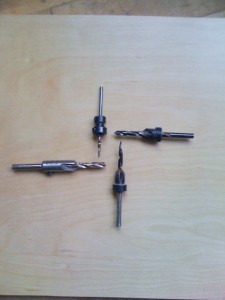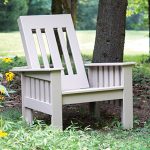We may receive a commission when you use our affiliate links. However, this does not impact our recommendations.
 When assembling cabinet parts using screws, drilling a clearance hole with a countersink is a necessity. A pilot hole for the screw may or may not be necessary at all. What’s the difference between a clearance hole and a pilot hole? A clearance hole will allow a screw to pass through it without the threads biting into the material. This is particularly important when using screws with threads that are formed on the entire length of the screw shank, as with drywall screws. A pilot hole, on the other hand, makes room for the screw shank yet provides material for the screw threads to thoroughly bite into the material securing the fastener. The pilot hole is necessary when the threat of splitting the material is likely. And the countersink, of course, allows the screw head to seat flush or below the face of the material.
When assembling cabinet parts using screws, drilling a clearance hole with a countersink is a necessity. A pilot hole for the screw may or may not be necessary at all. What’s the difference between a clearance hole and a pilot hole? A clearance hole will allow a screw to pass through it without the threads biting into the material. This is particularly important when using screws with threads that are formed on the entire length of the screw shank, as with drywall screws. A pilot hole, on the other hand, makes room for the screw shank yet provides material for the screw threads to thoroughly bite into the material securing the fastener. The pilot hole is necessary when the threat of splitting the material is likely. And the countersink, of course, allows the screw head to seat flush or below the face of the material.
The ideal drill bit for making all these required elements for fastening two pieces of wood together is very difficult to make and therefore not readily available. One solution is a “step drill” where the diameter of the leading part of the bit is correct for a desired pilot hole, then the diameter increases to make the clearance hole, with a countersink sits above as the final cutting element.
A variation of the step drill is the tapered bit, and the variables for such bits are many. What type and size screw are you using, what length is it, how thick is the material in use and how deep can you sink the screw? At times there’s yet another consideration – how deep can/should you countersink to get the optimum screw-holding power and not have the screw pass all the way through the second piece of material. This can be a very important.
Of course, without a proper-sized clearance hole the ability to draw the first piece of material tight to the second is compromised. Without a clearance hole, the screw threads are biting into the first piece, then thread into the second. It’s not unusual for the threads to actually hold to two pieces slightly apart at worst or not fully tightened to one another at best (called bridging). If you are screwing together pieces in a glued joint, there won’t be sufficient pressure on the two pieces to take full advantage of the glue. An exception is when the two pieces are clamped before the screws are inserted. Here’s a link to a helpful chart providing correct sizes for clearance and pilot holes for wood screws of various sizes.
Without the appropriate-sized step or tapered drill bit, the clearance hole trumps the pilot hole. Furthermore, drilling a clearance hole, then drilling a pilot hole in a second operation, is often problematic because of the difficulty of precisely locating the pilot hole. A less than perfectly placed pilot hole will lead to alignment issues between the parts.
In most cases, I drill a clearance hole then drive the screw without benefit of a pilot hole. Exceptions, of course, are if the material is too hard to drive a screw without fear of snapping the screw or if the screw is too large in size to drive into softer materials with snapping concerns or perhaps splitting the wood.
Hardware installation is another question. I always drill pilot holes for hinge screws etc. regardless of the screw being brass or steel.
If you build cabinets and furniture get our book, “Joinery Tips & Techniques” by the editors of Popular Woodworking Magazine. Or, check out “Simply Built Cabinets” by Danny Proulx.
Here are some supplies and tools we find essential in our everyday work around the shop. We may receive a commission from sales referred by our links; however, we have carefully selected these products for their usefulness and quality.









Chart Link goes to Google search, not a specific picture.
Helpful article for us newbies.
Thank you.
Steve